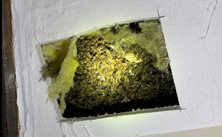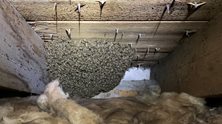We can remove colonies from attics, walls etc
Advice on swarms
Honey bee swarms are not angry and are unlikely to attack.
However, it is important that you correctly identify that the swarm is HONEY BEES and don't confuse it with bumble bees, wasps or hoverflies ( see pictures - click here for more information on identifying a swarm of Honey bees)
A spell of warm weather in early summer makes ideal conditions for honey bee colonies to start swarming.
Swarming is the natural way that a colony of honey bees reproduces. It happens when a new Queen has been formed and is almost ready to emerge from her cell.
As the number of bees in a hive grows the colony runs out of space and it’s time to split the colony and look for a new home. So they swarm.
Unlike humans the parent Queen and flying bees leave their home rather than waiting for the offsping to leave and set up independently.
In preparation honey bees gorge on honey prior to their journey in search of a suitable nesting site. When they are ready to go the bees leave the hive and can appear as a cloud in the air. We tend to spot them when they are resting as a cluster with the Queen at their centre. Without her there is no future for the colony.
The resting place for a swarm can be in the most unusual of places and should not be confused with a wasp nest. Swarming bees have little interest in people when in this mode. Their priority is to find a safe place to set up their new colony, so you have little to fear from them. You should still act with caution as they are a wild insect.
Honey bees are invaluable to our eco system; swarms need to be collected by a beekeper and put in a new hive so that they can
thrive, producing honey and even more importantly, pollinating food crops. With the pressure on bee numbers we can’t afford to lose swarms.
The British Beekeepers Association (BBKA) urges members of the public to learn how to spot a honey bee swarm and to know what to do when they see one.
"The public is increasingly aware of the importance of honey bees through their contribution to food production through pollination, not to mention the honey they produce. But a swarm of bees still can be scary. The public should not be alarmed if they see or come across a swarm of honey bees. They are doing what honey bees do naturally and are not remotely interested in humans. Contrary to some recent press headlines they are neither angry nor likely to attack.
In fact before leaving their hive the bees fill up their stomachs with honey and are rather mellow; their sole intention is to find a new home to build-up a new colony. As long as the swarm is not provoked it will not do any harm but it is important that the bees are collected by an experienced beekeeper.
If left to their own devices they may choose to set up home in the nearest (in)convenient spot which could be a chimney or other inappropriate place, where they will not thrive and may well be a nuisance."
Tim Lovett, BBKA Director of Public Affairs, gives some advice : “Honey bees swarm as nature’s way of increasing the number of colonies. With honey bee numbers under threat we can ill afford to lose swarms. As long as it is safe and practicable, beekeepers are keen to collect them and give them a new home. Swarms left uncollected are unlikely to survive, which means lost honey production but even more importantly, fewer of these hard working insects to pollinate crops, including our favourite fruits and vegetables.”
He continues; “however, people often mistake groups of other types of bees or wasps for honey bees. At this time of year the BBKA receives hundreds of calls; three out of four calls are about wasps’ nests, bumblebee sightings, or other flying insects and not honey bees which puts a huge strain on the resources of the our small office team. The public can help by contacting a beekeeper as soon as possible on sighting a swarm of honey bees ”
Contact Details :
Please mention that you found us through the 'Royal Burgh' website.
Telephone : 07549166731









